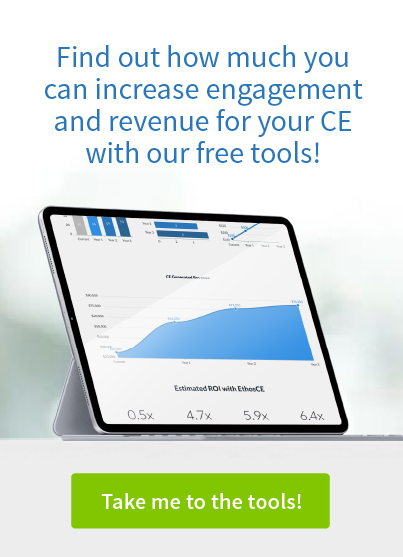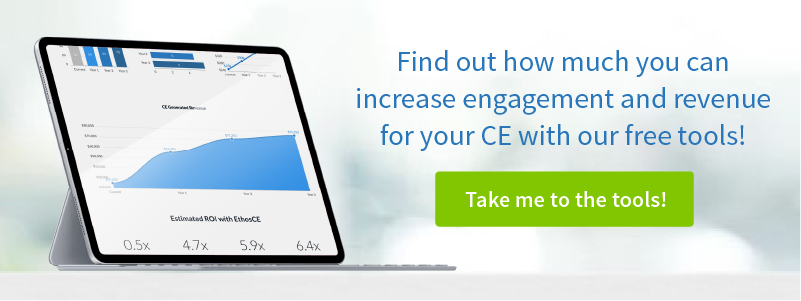Creating an Activity Completion report for CME, CNE, and CE
The creation of an activity completion report is one of the most exacting undertakings that a CE manager will face. However, since data management, analysis, and report creation can be complicated, it doesn’t have to intimidate. In this post, we’ll walk you through the creation of an activity completion report and show you the simplest way to pull, compile, and evaluate your data.
ACCME Activities Data Collection Requirements
First, let’s take a look at the data that ACCME will require you to collect:
- The type of your providership (direct or joint).
- The hours of instruction.
- What was each activity designed to change (competence, performance, or patient outcomes)?
- What changes in (competence, performance or patient outcomes) were evaluated?
- The number of physicians (including residents) who participated in the activity.
- Number of other non-physician learners who participated in the activity.
- The competencies addressed by the activity.
- Name(s) of Joint Providers (jointly-provided activities only).
- The total amount of commercial support received, including monetary support and in-kind commercial support, and the names of commercial supporters.
- Name(s) of commercial supporter(s) and monetary amount/nature of in-kind support received from each supporter.
- The amount of AMA PRA Category 1 Credit™ designated per activity.
Along with this information, you’ll need to enter information about the management of your CME program:
- The amount of advertising and exhibit income received in support of your CME Program.
- All registration fees received (registration fees received from CME activity participants).
- Total government monetary grants received from federal, state, or local governmental agencies in support of your program.
- All private monetary donations received (monetary donations received from the private sector, including foundations, in support of your CME Program).
Key “Quality Control” Issues in Looking at Activity Completion Data
So now that you’ve got your list of required data, where do you start? If you’re seeking reaccreditation, then your information will most likely have changed since you initially won accreditation. If you are a first-timer, then you’ll have some extra work to do in creating an efficient method of collecting and analyzing your data.
The “freshness” of your data and how it’s handled will determine the accuracy of your activities evaluations, so you’ll want to be a bit fanatical about quality control. Here are three key elements to keep an eye on:
- Am I using the most recent data?
It’s important to monitor learner outcome data consistently, and not rely on information that is even a few months old. You’ll want to present the best possible portrait of what your program has achieved, and that means using information that shows the most recent learner outcome improvements. - Am I avoiding human error as much as possible in my data collection process?
The ACCME doesn’t expect perfection, but if you can get pretty close to it, then why not? Manual data collection from your LMS can be mind-numbingly tedious and prone to inaccuracy. That’s a significant risk to take: a few entry errors can alter the findings of your activity completion report. Be exacting in your review of each learner outcome summary. - Is the data that I’m using segmented correctly?
Another potential problem with entering data manually is determining if you’re looking at the right numbers within the right context. You’ll need to be certain, for example, that your account of positive learner outcomes incorporates results for students completing activities, rather than for those who started, did well, and then dropped out. This is important because you’ll need accurate figures regarding course completion rates for your report, as well as to develop a clear action plan to improve learner engagement. - Can I present my data within the context of my CME program’s overall impact on learner competence?
It is one thing to have a great data set, but quite another to be able to transform that data into a compelling narrative. The latter is what the ACCME requires. To do this, you will need to take a long look at what your activities data reveals about your program’s current ability to meet projected learner outcomes. According to the ACCME:
“An assessment of change is required for each CME activity. The information is then analyzed by the CME provider in the context of the overall program’s effectiveness. Criteria 11 and 12 require the provider to understand the effectiveness of their Program of CME in the context of changes in competence, performance, or patient outcomes.”
If you aren’t pleased with your program’s track record so far, don’t worry. The ACCME also looks at how your association identified and addressed the obstacles that it encountered in fulfilling its CME objectives While a flawless execution of every projected outcome would be great, it’s not realistic, and the ACCME doesn’t expect it.
That said, everything comes back to the data. If you can collect, manage, and interpret it correctly, you will have solved one of your most significant challenges as a CE manager. Using a CME management platform like EthosCE which automates data collection, analysis, and PARS-compliant report submissions is a smart choice if you want to avoid a time-consuming review which you may have to repeat more than once.
How a CME Management Platform Can Provide a Solution for Reporting Tasks
If you’ve decided to use an LMS management platform to streamline your activities report creation, here are a few components that you should look for, in addition to automated data management:
- Automated attendance tracking of RSS/Grand Rounds via mobile phones
- Self-serve certificates
- Support for multiple credit types
- Unlimited certificate templates
- Commitment to change and follow-up assessment instruments
- PARS-compliant reports and integration with ACCME web services, including ABA, ABIM, ABP MOC 2 programs
- Automated reporting to boards and other external systems, including ACCME PARS, CE Broker, CPE Monitor, and more.
- Complete CME tracking lifecycle management
Year-end activity report creation doesn’t have to bring your workflow to a standstill. Using EthosCE, your activities monitoring and data collection—the most time-consuming elements of report creation—will happen automatically. You’ll be able to click to submit PARS-compliant reports using fresh data that you never had to touch. If you’re ready to find out how easy CME management can be, take a look at our features and get in touch for a demo.
 We're now part of the Cadmium product suite! Learn more
We're now part of the Cadmium product suite! Learn more 

